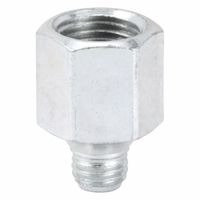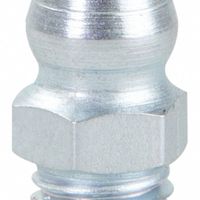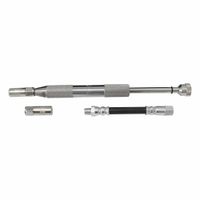Call +(254) 703 030 000 / 751 483 999 / 721 704 777
- Home
- Lubrication
- Grease Fittings For Equipment
.....Read More
Frequently Asked Questions
What are grease fittings and how do they work?
Grease fittings, also known as zerk fittings or grease nipples, are small mechanical components used in machinery to provide a convenient way to apply lubrication, typically grease, to bearings, bushings, and other moving parts. They consist of a small ball check valve that allows grease to be injected into a lubrication point using a grease gun, while preventing contaminants from entering and grease from leaking out.
Here's how they work:1. **Connection:** A grease gun, which is a tool used to pump grease under pressure, is attached to the fitting. The end of the grease gun creates a seal around the fitting.
2. **Injection:** When the handle of the grease gun is squeezed, it forces grease through the gun and into the fitting.
3. **Ball Valve:** Inside the fitting, there's a small spring-loaded ball. The pressure from the grease overcomes the spring's resistance, pushing the ball inward and opening a path for the grease to flow into the component being lubricated.
4. **Lubrication:** The grease travels through internal passages within the component, reaching the moving parts that require lubrication.
5. **Sealing:** Once the grease gun is removed, the spring pushes the ball back into its original position, sealing the fitting and preventing grease from escaping or dirt and debris from entering.Grease fittings are essential for maintaining the smooth operation and longevity of machinery by ensuring proper lubrication, which reduces friction, wear, and heat buildup. They come in various sizes and angles to accommodate different applications and access requirements.
How do you install a grease fitting?
To install a grease fitting:1. **Clean the area:** Ensure the surface where the fitting will be installed is clean and free of debris, old grease, or rust. This prevents contaminants from entering the system.
2. **Choose the correct fitting:** Select a grease fitting with the correct thread size and type for the application. Common types include straight, 45-degree, and 90-degree angles.
3. **Thread sealant (optional but recommended):** Apply a small amount of thread sealant (like PTFE tape or liquid sealant) to the threads of the new grease fitting. This helps prevent leaks and ensures a good seal.
4. **Hand-tighten:** Carefully thread the new grease fitting into the designated port by hand. Ensure it starts straight to avoid cross-threading.
5. **Wrench-tighten:** Once hand-tight, use an appropriately sized wrench or socket to tighten the fitting. Tighten it securely, but do not overtighten, as this can damage the threads or the component itself. The specific torque may vary, so consult the equipment manufacturer's guidelines if available.
6. **Test (optional):** After installation, a small amount of grease can be applied to the fitting to confirm proper function and check for any leaks.
What tools are needed for installing grease fittings?
Installing grease fittings primarily requires a grease fitting tool, which is a specialized wrench or socket designed to securely grip the hexagonal or square head of the fitting. Some tools offer interchangeable heads to accommodate various fitting sizes. Additionally, a thread sealant, such as Teflon tape or liquid pipe sealant, is recommended to prevent leaks and ensure a tight seal. For removing old or damaged fittings, a grease fitting extractor or a standard wrench may be necessary. Safety glasses are also advisable to protect your eyes from any debris or grease during the installation process.
How do you maintain and clean grease fittings?
Please specify the topic you would like me to elaborate on.
What are the different types of grease fittings?
Grease fittings, also known as Zerk fittings, are small mechanical devices that allow lubricants (grease) to be injected into a bearing or other mechanical component under pressure, typically using a grease gun. They come in various types, primarily differing in their angle, thread size, and material, to suit different applications and space constraints.
The most common types include: * **Straight fittings (0-degree):** These are the most basic and are used when there's direct access to the lubrication point.
* **Angle fittings (e.g., 45-degree, 67.5-degree, 90-degree):** These are designed for lubrication points that are difficult to access directly. The angle allows for easier attachment of the grease gun in confined spaces or around obstructions.
* **Button head fittings:** These have a larger, flatter head and are often found on heavy machinery or equipment where a higher volume of grease is required or where frequent lubrication is necessary. They are designed for use with a larger, specialized grease gun coupler.
* **Flush type fittings:** These are designed to be nearly flush with the surface of the component, minimizing protrusions and potential snagging in certain applications. They may require a specific adapter for lubrication.
* **Drive-in fittings:** Instead of having threads, these fittings are simply pressed or hammered into a hole, often used in applications where threading is not feasible or desired.
* **Relief fittings:** These have a built-in pressure relief mechanism that allows excess grease to escape if the pressure becomes too high, preventing damage to seals or bearings from over-pressurization.Beyond the angle and head type, grease fittings also vary by thread size (e.g., 1/4"-28, 1/8" NPT) and material (e.g., steel, stainless steel, brass) to match the equipment's specifications and environmental conditions.
How do you choose the right grease fitting for your equipment?
Choosing the right grease fitting for your equipment is crucial for proper lubrication and preventing premature wear. Consider the following factors:1. Type of fitting: Common types include Zerk fittings (most common), button head, and flush-type. The choice depends on the application, pressure requirements, and access to the lubrication point. Zerk fittings are good for general use, while button head fittings are often used in high-pressure or heavy-duty applications.
2. Thread size and pitch: Ensure the fitting's threads match the equipment's port to prevent leaks and ensure a secure connection. Common thread types include NPT, BSP, and metric.
3. Angle and configuration: Fittings come in various angles (straight, 45-degree, 90-degree) to facilitate easy access for a grease gun in tight or awkward spaces.
4. Material: Fittings are typically made from steel, stainless steel, or brass. Steel is suitable for general industrial use, stainless steel offers corrosion resistance for harsh environments, and brass is preferred for applications where spark resistance or non-magnetic properties are required.
5. Pressure rating: Select a fitting that can withstand the maximum pressure of your lubrication system to prevent blowout and ensure efficient grease delivery.
6. Special features: Some fittings offer features like check valves to prevent backflow or tamper-resistant designs for sensitive applications.By considering these aspects, you can select the optimal grease fitting to ensure efficient lubrication and extend the lifespan of your equipment.
Can grease fittings be replaced if damaged?
Yes, grease fittings can be replaced if damaged. They are typically threaded into a component and can be unscrewed and replaced with a new fitting of the same size and type. It's important to use the correct tool, often a wrench or a specialized grease fitting tool, to avoid further damage during removal and installation. If a fitting is seized or broken, it may require careful extraction to avoid damaging the underlying component. Regularly inspecting and replacing damaged grease fittings ensures proper lubrication and extends the life of the machinery.
How do adapters and manifolds work with grease fittings?
Adapters and manifolds play crucial roles in optimizing the functionality of grease fittings, especially in complex lubrication systems. Adapters act as connectors, allowing different types or sizes of grease fittings to be used with a single grease gun or lubrication point. This flexibility is essential when dealing with machinery that has a variety of fitting types or when a specific angle or extension is needed to access a hard-to-reach fitting.
Manifolds, on the other hand, are designed to distribute grease from a single input source to multiple grease fittings simultaneously. This is particularly useful in systems with numerous lubrication points that require regular greasing. By centralizing the greasing process, manifolds help to save time, reduce the risk of missing lubrication points, and ensure consistent grease delivery across the system. Both components work together to enhance the efficiency, accessibility, and overall effectiveness of lubrication in various mechanical applications.
What are common problems with grease fittings and how to fix them?
Common problems with grease fittings include clogging, damage, and improper seating. Clogging often occurs due to old, hardened grease or contaminants, preventing new grease from entering. To fix this, a grease fitting cleaner tool can be used to break up the clog, or the fitting may need to be replaced. Damaged fittings, such as bent or broken ones, will not allow grease to pass through or will leak. These should be replaced immediately. Improper seating, where the fitting is not screwed in tightly enough or the threads are stripped, can also lead to leaks. In such cases, tighten the fitting, use thread sealant, or replace the fitting if the threads are damaged. Regular maintenance, including cleaning and inspecting fittings, can prevent these issues.
How often should grease fittings be lubricated?
Please specify the topic you would like me to elaborate on.


